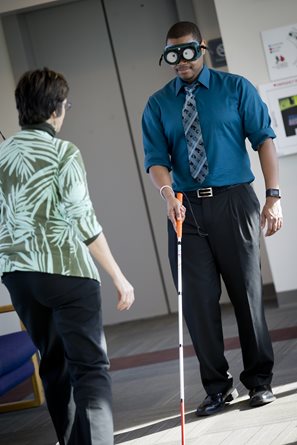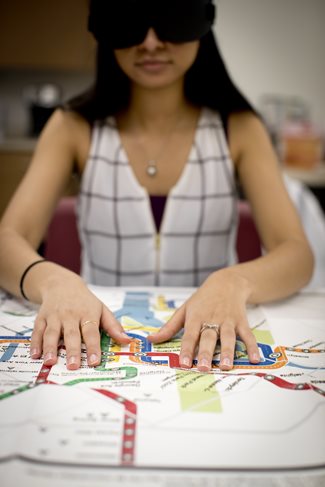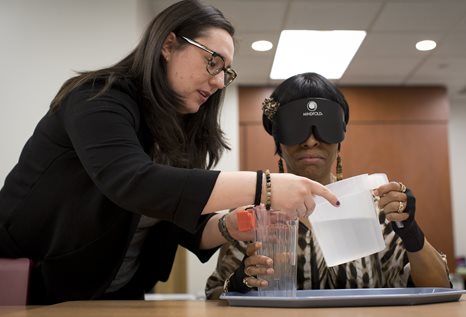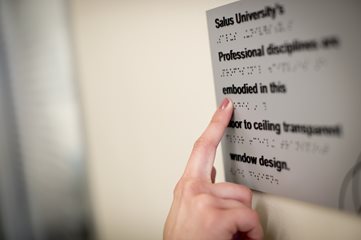Enriching the Lives of Those with Visual Impairments: A Career in Blindness and Low Vision
 A master’s degree or certificate in one of Salus University’s Blindness and Low Vision Studies (BLVS) programs opens the door to a variety of career options. Housed in the College of Education and Rehabilitation, the University offers four specialty areas all focused on assisting those with visual impairments — Orientation & Mobility, Low Vision Rehabilitation, Vision Rehabilitation Therapy, and Education of Children and Youth with Visual Impairments. Learning about the variety of opportunities each program of study offers is the first step in understanding which area of BLVS to pursue.
A master’s degree or certificate in one of Salus University’s Blindness and Low Vision Studies (BLVS) programs opens the door to a variety of career options. Housed in the College of Education and Rehabilitation, the University offers four specialty areas all focused on assisting those with visual impairments — Orientation & Mobility, Low Vision Rehabilitation, Vision Rehabilitation Therapy, and Education of Children and Youth with Visual Impairments. Learning about the variety of opportunities each program of study offers is the first step in understanding which area of BLVS to pursue.
An Orientation & Mobility (O&M) Specialist focuses on teaching independent traveling skills to both children and adults who are blind or have low vision. O&M specialists typically work with clients one-on-one in both indoor and outdoor environments, using long canes or other mobility devices. Instruction is tailored to each individual and focuses on utilizing an individual’s remaining senses and problem-solving abilities. They strive to instill independence and confidence in their clients as they instruct them using various skills to orient themselves and move safely in and through their world.
O&M specialist can work with any age – infants to geriatric groups. One day they may be helping an infant with low vision crawl across the floor toward a musical toy, and another they may be teaching a college student to locate various classrooms around campus and cross busy intersections to reach the bus stop.
O&M specialists work in a variety of settings such as schools, transportation agencies, assisted living or nursing homes, rehabilitation facilities, or hospitals.
Most O&M specialists must attain a bachelor’s degree, paired with a certificate in O&M, or master’s degree. They must also pass the Certified Orientation and Mobility Specialist (COMS) exam, administered by the Academy for Certification of Vision Rehabilitation and Education Professionals (ACVREP).
 What does a Low Vision Therapist Do?
What does a Low Vision Therapist Do?Low Vision Therapists (LVTs) focus on maximizing the functional vision of patients who have low vision. Working as a team member in a low vision clinic, LVTs strive to improve patients’ quality of life by providing them with instruction on the use of functional tools and tactics such as magnifiers and telescopes, manipulating lighting and contrast for ease of reading/visibility, and using applications on smartphone designed to assist those with low vision. An LVT’s duties can range from showing a patient how lighting affects readability to showing a patient how to use an app for money identification, to using a handheld magnifier for reading a utility bill.
LVTs can be found in clinical settings such as eye care facilities working alongside an interdisciplinary team of optometrists and social work staff members, such as at the William Feinbloom Vision Rehabilitation Center, housed in The Eye Institute. LVTs can also work in homes of the blind or visually impaired, vision rehabilitation facilities, hospitals, VA Medical Centers, or educational institutions.
One must pass the CLVT exam administered by the Academy for Certification of Vision Rehabilitation and Education Professionals (ACVREP).
Vision Rehabilitation Therapists (VRTs) work with visually impaired clients on expanding their independence by providing strategies on how to perform certain activities of daily living such as preparing meals and household chores, among others. Every day is different for a VRT and incorporating creative solutions is key to making a difference in the lives of those with visual impairments. VRTs may teach clients how to read a Braille menu, how to distinguish which spices are which while cooking, or how to select a coordinated outfit for an important occasion.
VRTs work in a wide range of settings, including the homes of those who are blind or have visual impairments, rehabilitation centers, hospitals, assisted living or nursing homes, or schools.

VRTs must have a bachelor’s degree, and a mater’s degree or certificate is typically required. They may also attain further certification by passing the Academy for Certification of Vision Rehabilitation and Education Professionals’ (ACVREP) Certified Vision Rehabilitation Therapist exam.
 What does an Educator of Children with Visual Impairments Do?
What does an Educator of Children with Visual Impairments Do?Educators of the visually impaired work with children from birth to 21 years old who are completely blind or visually impaired, teaching them a variety of skills for independence, which are especially important during their learning years. Example job duties for a teacher of the visually impaired include training a first grader who is blind to read and write using Braille, working on social skills with a visually impaired third grader so they can confidently interact with peers, or working with the after school basketball coach on how to accommodate a blind fifth grader who wants to join to team.
Teachers of the visually impaired work primarily in school settings. They may work in public schools, in multiple classrooms assisting students, or directly in the homes of children with visual impairments. They work closely with the child’s parents to ensure that they are key members of the child’s educational support system.
Educators of the visually impaired may be current teachers looking to add a specialty certification to their existing teaching repertoire or those with a bachelor’s degree who wish to work with a specific special needs population. In order to teach professionally, a bachelor’s or master’s degree in education in visual impairment must be earned.
Established in 1983, the University’s BLVS Department was the first institution in the US to offer four master’s and certification programs for blindness and low vision professionals. Each program strives to enhance the lives of people who are blind or have low vision through interprofessional education, service delivery and research.